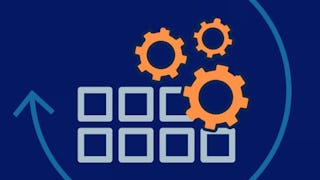DataOps is defined by Gartner as "a collaborative data management practice focused on improving the communication, integration and automation of data flows between data managers and consumers across an organization. Much like DevOps, DataOps is not a rigid dogma, but a principles-based practice influencing how data can be provided and updated to meet the need of the organization’s data consumers.”



(55 reviews)
Recommended experience
What you'll learn
Understand the process to establish a repeatable process that delivers rigor and repeatability
Articulate the business value of any data sprint by capturing the KPI's the sprint will deliver
Understand how to enable the organization's business, development and operations to continuously design, deliver and validate new data demands
Skills you'll gain
Details to know

Add to your LinkedIn profile
14 assignments
See how employees at top companies are mastering in-demand skills


Earn a career certificate
Add this credential to your LinkedIn profile, resume, or CV
Share it on social media and in your performance review

There are 7 modules in this course
In this module you will learn the fundamentals of a DataOps approach. You will learn about the people who are involved in defining data, curating it for use by a wide variety of data consumers, and how they can work together to deliver data for a specific purpose:
What's included
11 videos2 assignments
In this lesson you will learn the fundamentals of a DataOps approach. You will learn about how the DataOps team works together in defining the business value of the work they undertake to be able to clearly articulate the value they bring to the wider organization:
What's included
10 videos3 assignments
In this lesson you will learn about the capabilities that you will need to use to understand the data in repositories across an organization. Data discovery is most appropriately employed when the scale of available data is too vast to devise a manual approach or where there has been institutional loss of data cataloging. It utilizes various techniques to programmatically recognize semantics and patterns in data. It is a key aspect of identifying and locating sensitive or regulated data to adequately protect it, although in general, knowing what stored data means unlocks its potential for use in analytics. Data Classification provides a higher level of semantic enrichment, enabling the organization to raise data understanding from technical metadata to a business understanding, further helping to discover the overlap between multiple sources of data according to the information that they contain:
What's included
2 videos2 assignments
In this lesson you will learn that understanding data semantics helps data consumers to know what is available for consumption, but it does not provide any guidance on how good that data is. This module is all about trust, how reliable a data source can be in providing high fidelity data that can be used to drive key strategic decisions, and whether that data should be accessible to those who want to use it; whether the data consumer is permitted to see and use it. This module will address the common dimensions of data quality, how to both detect and remediate poor data quality. And it will look at enforcing the many policies that are needed around data quality, not least the need to respect an individual’s wishes and rights around how their data is used:
What's included
3 videos1 reading2 assignments
In this lesson you will learn that providing useful data in a catalog can often necessitate some transformation of that data. Modifying original data can optimize data ingestion in various use-cases, such as combining multiple data sets, consolidating multiple transaction summaries, or manipulating non-standard data to conform to international standards. This module will examine the choices for data preparation, how visualization can be used to facilitate the human understanding of the data and what needs to be changed, and the various options for single use, optimization of data workflows and ensuring the regular production of transformations for operational use. Furthermore, this module will show you how to plan and implement the data movement and integration tasks that are required to support a business use case. The module is based on a real-world data movement and integration project required to support implementation of an AI-based SaaS analytical system for supply chain management running in the Google cloud. The module will cover the major topics that need to be addressed to complete a data movement and integration project successfully:
What's included
4 videos1 reading3 assignments
In this lesson you will learn about evaluating the last data sprint, observe what worked and what did not, and make recommendations on how the next iteration could be improved.
What's included
1 video1 assignment
What's included
1 video1 assignment
Instructor

Offered by
Explore more from Data Analysis


Duke University


University of Maryland, College Park
Why people choose Coursera for their career




Learner reviews
55 reviews
- 5 stars
71.42%
- 4 stars
25%
- 3 stars
1.78%
- 2 stars
1.78%
- 1 star
0%
Showing 3 of 55
Reviewed on Jul 26, 2024
Very clearly explained the DataOps concepts. Thank you very much.
Reviewed on Nov 21, 2024
Absolutely amazing content! structural and give you an overall view of data management
Reviewed on Jul 31, 2022
Great over view and good breakdown of the concepts
New to Data Analysis? Start here.

Open new doors with Coursera Plus
Unlimited access to 10,000+ world-class courses, hands-on projects, and job-ready certificate programs - all included in your subscription
Advance your career with an online degree
Earn a degree from world-class universities - 100% online
Join over 3,400 global companies that choose Coursera for Business
Upskill your employees to excel in the digital economy
Frequently asked questions
Access to lectures and assignments depends on your type of enrollment. If you take a course in audit mode, you will be able to see most course materials for free. To access graded assignments and to earn a Certificate, you will need to purchase the Certificate experience, during or after your audit. If you don't see the audit option:
The course may not offer an audit option. You can try a Free Trial instead, or apply for Financial Aid.
The course may offer 'Full Course, No Certificate' instead. This option lets you see all course materials, submit required assessments, and get a final grade. This also means that you will not be able to purchase a Certificate experience.
When you purchase a Certificate you get access to all course materials, including graded assignments. Upon completing the course, your electronic Certificate will be added to your Accomplishments page - from there, you can print your Certificate or add it to your LinkedIn profile. If you only want to read and view the course content, you can audit the course for free.
You will be eligible for a full refund until two weeks after your payment date, or (for courses that have just launched) until two weeks after the first session of the course begins, whichever is later. You cannot receive a refund once you’ve earned a Course Certificate, even if you complete the course within the two-week refund period. See our full refund policy.
More questions
Financial aid available,






